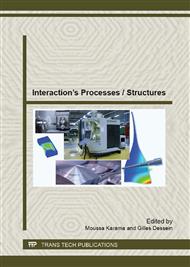[1]
Ezugwu E. O., 2005, "Key improvements in the machining of difficult-to-cut aerospace superalloys," International Journal of Machine Tools and Manufacture, 45(12-13), p.1353–1367.
DOI: 10.1016/j.ijmachtools.2005.02.003
Google Scholar
[2]
KONIG W., 1978, "Applied Research on the Machinability of Titanium and its Alloys," Proceedings of 47th Meeting of AGARD Structural and Materials Panel, Florence, Italy, p.1.1–1.10.
Google Scholar
[3]
Sun J., and Guo Y. B., 2008, "A new multi-view approach to characterize 3D chip morphology and properties in end milling titanium Ti-6Al-4V," International Journal of Machine Tools and Manufacture, 48(12-13), p.1486–1494.
DOI: 10.1016/j.ijmachtools.2008.04.002
Google Scholar
[4]
Ezugwu E. O., and Wang Z. M., 1997, "Titanium alloys and their machinability–a review," Journal of Materials Processing Technology, 68(3), p.262–274.
DOI: 10.1016/s0924-0136(96)00030-1
Google Scholar
[5]
Ulutan D., and Ozel T., 2011, "Machining induced surface integrity in titanium and nickel alloys: A review," International Journal of Machine Tools and Manufacture, 51(3), p.250–280.
DOI: 10.1016/j.ijmachtools.2010.11.003
Google Scholar
[6]
Geng G. S., and Xu J. H., 2008, "Surface Integrity and Fatigue Property of a High Speed Milled Titanium Alloy," Advanced Materials Research, 53-54, p.305–310.
DOI: 10.4028/www.scientific.net/amr.53-54.305
Google Scholar
[7]
Ribeiro M. V., Moreira M. R. V., and Ferreira J. R., 2003, "Optimization of titanium alloy (6Al-4V) machining," Journal of Materials Processing Technology, 143-144, p.458–463.
DOI: 10.1016/s0924-0136(03)00457-6
Google Scholar
[8]
Che-Haron C. H., and Jawaid A., 2005, "The effect of machining on surface integrity of titanium alloy Ti-6% Al-4% V," Journal of Materials Processing Technology, 166(2), p.188–192.
DOI: 10.1016/j.jmatprotec.2004.08.012
Google Scholar
[9]
Ibrahim G. ., Haron C. . C., and Ghani J. ., 2009, "The effect of dry machining on surface integrity of titanium alloy Ti-6Al-4V ELI," Journal of Applied Sciences, 9, p.121–127.
DOI: 10.3923/jas.2009.121.127
Google Scholar
[10]
Elmagrabi N., Hassan C. . C., Jaharah A. ., and Shuaeib F. ., 2008, "High speed milling of Ti-6Al-4V using coated carbide tools," European Journal of Scientific Research, 22(2), p.153–162.
Google Scholar
[11]
Sun J., and Guo Y. B., 2009, "A comprehensive experimental study on surface integrity by end milling Ti-6Al-4V," Journal of Materials Processing Technology, 209(8), p.4036–4042.
DOI: 10.1016/j.jmatprotec.2008.09.022
Google Scholar
[12]
Hughes J. I., Sharman A. R. C., and Ridgway K., 2006, "The Effect of Cutting Tool Material and Edge Geometry on Tool Life and Workpiece Surface Integrity," Proceedings of the Institution of Mechanical Engineers, Part B: Journal of Engineering Manufacture, 220(2), p.93–107.
DOI: 10.1243/095440506x78192
Google Scholar
[13]
Narutaki N., Murakoshi A., Motonishi S., and Takeyama H., 1983, "Study on Machining of Titanium Alloys," CIRP Annals - Manufacturing Technology, 32(1), p.65–69.
DOI: 10.1016/s0007-8506(07)63362-9
Google Scholar
[14]
Velasquez J. D. P., Bolle B., Chevrier P., and Tidu A., 2006, "SURFACE INTEGRITY IN HIGH SPEED MACHINING OF Ti-6wt.%Al-4wt.%V ALLOY," Residual Stress and Its Effects on Fatigue and Fracture, p.87–95.
DOI: 10.1007/1-4020-4972-2_655
Google Scholar
[15]
Bouchnak T. B., 2010, "Etude du comportement en sollicitations extrêmes et de l'usinabilité d'un nouvel alliage de titane aéronautique : le Ti555-3," Ecole Nationale Supérieure d'Arts et Métiers.
Google Scholar
[16]
Chen L., El-Wardany T. I., and Harris W. C., 2004, "Modelling the Effects of Flank Wear Land and Chip Formation on Residual Stresses," CIRP Annals - Manufacturing Technology, 53(1), p.95–98.
DOI: 10.1016/s0007-8506(07)60653-2
Google Scholar
[17]
Che-Haron C. H., 2001, "Tool life and surface integrity in turning titanium alloy," Journal of Materials Processing Technology, 118(1-3), p.231–237.
DOI: 10.1016/s0924-0136(01)00926-8
Google Scholar
[18]
VELASQUEZ J. D. P., 2007, "Etude des copeaux et de l'intégrité de surface en usinage à grande vitesse de l'alliage de titane TA6V," University Paul Verlaine.
Google Scholar
[19]
Reissig L., Völkl R., Mills M. J., and Glatzel U., 2004, "Investigation of near surface structure in order to determine process-temperatures during different machining processes of Ti6Al4V," Scripta Materialia, 50(1), p.121–126.
DOI: 10.1016/j.scriptamat.2003.09.023
Google Scholar
[20]
Cantero J. L., Tardío M. M., Canteli J. A., Marcos M., and Miguélez M. H., 2005, "Dry drilling of alloy Ti–6Al–4V," International Journal of Machine Tools and Manufacture, 45(11), p.1246–1255.
DOI: 10.1016/j.ijmachtools.2005.01.010
Google Scholar
[21]
Li R., Riester L., Watkins T. R., Blau P. J., and Shih A. J., 2008, "Metallurgical analysis and nanoindentation characterization of Ti–6Al–4V workpiece and chips in high-throughput drilling," Materials Science and Engineering: A, 472(1–2), p.115–124.
DOI: 10.1016/j.msea.2007.03.054
Google Scholar
[22]
Zhou L., Shimizu J., Muroya A., and Eda H., 2003, "Material removal mechanism beyond plastic wave propagation rate," Precision Engineering, 27(2), p.109–116.
DOI: 10.1016/s0141-6359(02)00124-1
Google Scholar
[23]
Ezugwu E. O., Bonney J., Da Silva R. B., and Çakir O., 2007, "Surface integrity of finished turned Ti–6Al–4V alloy with PCD tools using conventional and high pressure coolant supplies," International Journal of Machine Tools and Manufacture, 47(6), p.884–891.
DOI: 10.1016/j.ijmachtools.2006.08.005
Google Scholar
[24]
Kitagawa T., Kubo A., and Maekawa K., 1997, "Temperature and wear of cutting tools in high-speed machining of Inconel 718 and Ti-6Al-6V-2Sn," Wear, 202(2), p.142–148.
DOI: 10.1016/s0043-1648(96)07255-9
Google Scholar
[25]
Welsch G., Boyer R., and Collings E. W., 1994, Materials properties handbook: Titanium alloys, ASM International.
Google Scholar
[26]
Banerjee R., Collins P. ., Bhattacharyya D., Banerjee S., and Fraser H. ., 2003, "Microstructural evolution in laser deposited compositionally graded alpha/beta titanium-vanadium alloys," Acta Materialia, 51(11), p.3277–3292.
DOI: 10.1016/s1359-6454(03)00158-7
Google Scholar
[27]
Craighead C. M., Simmons O. W., and Eastwood L. W., 1950, "Titanium Binary Alloys," TRANSACTIONS AIME, 188.
Google Scholar


